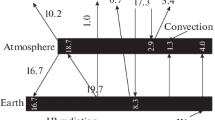Abstract
The results of the study of the radiation spectra of the Earth’s atmosphere in the ultraviolet (UV) and visible spectral regions are presented. The input window of the spectrometer was directed to the Sun or located at different angles to the axis through the solar disk center. The Vavilov–Cherenkov (VCh) radiation spectrum was recorded with a standard spectrometer in the region 200–300 nm for the first time. The threshold electron energy for VCh radiation excitation in air and the maximal angle of VCh radiation propagation with respect to the electron motion direction are calculated. The VCh radiation is assumed to be excited when high-energy solar wind particles are braking in the Earth’s atmosphere.


Similar content being viewed by others
REFERENCES
Handbook of Geophysics and Space Environments, Ed. by S. L. Valley (McGraw-Hill, New York, 1965).
S. I. Akasofu and S. Chapman, Solar-Terrestrial Physics (The Clarendon press, Oxford, 1972).
V. V. Chukin, Electromagnetic Examination of the Atmosphere (RGGMU, St. Petersburg, 2004) [in Russian].
N. N. Shefov, A. I. Semenov, and V. Yu. Khomich, Radiation of the Upper Atmosphere as an Indicator of its Structure and Dynamics (GEOS, Moscow, 2006) [in Rusian].
S. M. Kolomiets, “Vertical ionospheric sounding using the artificial Earth satellites with the passive response,” Issled. Oblasti Estestv. Nauk, No. 11 (2014).
M. A. Tashchilin and A. V. Mikhalev, “Springtime feature of the seasonal behavior of near-ground ultraviolet radiation in certain regions of Russia,” Atmos. Ocean. Opt. 23 (4), 303–308 (2010).
N. E. Chubarova, Yu. M. Timofeev, Ya. A. Virolainen, and A. V. Polyakov, “Estimates of UV indices during the periods of reduced ozone content over Siberia in winter-spring 2016,” Atmos. Ocean. Opt. 32 (2), 177–179 (2019).
V. P. Zrelov, Vavilov–Cherenkov Radiation and Its Use in High Energy Physics. Vol. 1 (Atomizdat, Moscow, 1968) [in Russian].
L. D. Landau and E. M. Lifshits, Theoretical Physics. Vol. 8 (Nauka, Moscow, 1982) [in Russian].
D. A. Sorokin, A. G. Burachenko, D. V. Beloplotov, V. F. Tarasenko, E. Kh. Baksht, E. I. Lipatov, and M. I. Lomaev, “Luminescence of crystals excited by a runaway electron beam and by excilamp radiation with a peak wavelength of 222 nm,” J. Appl. Phys. 122, 093304 (2017).
Y. Tsunesada, R. Katsuya, Y. Mitsumori, K. Nakayama, F. Kakimoto, H. Tokuno, N. Tajima, P. Miranda, J. Salinas, and W. Tavera, “New air Cherenkov light detectors to study mass composition of cosmic rays with energies above knee region,” Nucl. Instrum. Methods Phys. Res. A 763, 320–328 (2014).
J. M. Clem, P. Niessen, and S. Stoyanov, “Response of IceTop tanks to low-energy particles,” in Proc. 30th Intern. Cosmic Ray Conf. (Mexico City, 2008), Vol. 1(SH), p. 237–240.
K. D. De Vries, A. M. Berg, O. Scholten, and K. Werner, “Coherent Cherenkov radiation from cosmic-ray-induced air showers,” Phys. Rev. Lett. 107, 061101 (2011).
F. Bagnato, A. Romano, P. Buratti, A. Doria, L. Gabellieri, E. Giovenale, and M. Rabinski, “Triple Cherenkov probe measurements on FTU: Calibration and runaway energy spectra,” Plasma Phys. Controlled Fusion 60 (11), 115010 (2018).
E. I. Lipatov, D. E. Genin, D. V. Grigor’ev, V. F. Tarasenko, A. G. Burachenko, E. Kh. Baksht, and D. V. Beloplotov, “Applied optical properties of diamond,” AIP Conf. Proc. 2069, 040007(1–8) (2019).
V. F. Tarasenko, M. I. Lomaev, E. Kh. Baksht, D. V. Beloplotov, A. G. Burachenko, D. A. Sorokin, and E. I. Lipatov, “Spectral and amplitude-time characteristics of crystals excited by a runaway electron beam,” Matter Radiat. Extremes 4, 037401 (2019).
E. Kh. Baksht, A. V. Vukolov, M. V. Erofeev, G. A. Naumenko, A. P. Potylitsyn, V. F. Tarasenko, A. G. Burachenko, and M. V. Shevelev, “Cherenkov radiation in the visible and ultraviolet spectral ranges from 6-MeV electrons passing through a quartz plate,” JETP Lett. 109 (9), 564–568 (2019).
Funding
This work was financially supported by the Russian Science Foundation (project no. 18-19-00184).
Author information
Authors and Affiliations
Corresponding authors
Ethics declarations
The authors declare that they have no conflicts of interest.
Additional information
Translated by S. Ponomareva
Rights and permissions
About this article
Cite this article
Lipatov, E.I., Tarasenko, V.F., Erofeev, M.V. et al. Vavilov–Cherenkov Radiation in the Region 200–300 nm in the Earth’s Atmosphere. Atmos Ocean Opt 33, 195–197 (2020). https://doi.org/10.1134/S1024856020020049
Received:
Revised:
Accepted:
Published:
Issue Date:
DOI: https://doi.org/10.1134/S1024856020020049




